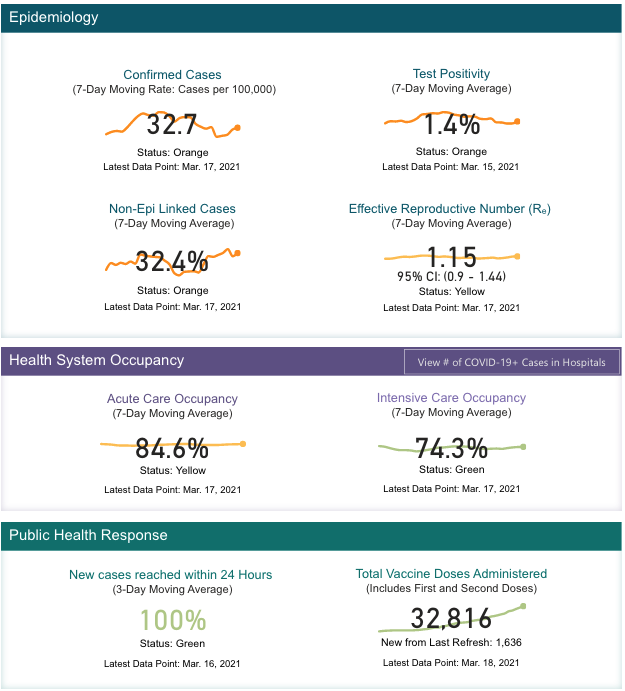GUELPH — It turns out the Wellington-Dufferin-Guelph Public Health (WDGPH) region will move to the orange level of the province’s COVID-19 framework on March 22 after all.
“We were surprised,” WDGPH spokesperson Danny Williamson said of the call from the province relaying the news at about 3:30pm on March 19.
For most of the day public health officials were under the impression the region would remain in the red zone. Williamson told the Advertiser as much earlier in the day and the newspaper posted an online story containing the inaccuracy.
Williamson apologized for the error, noting WDGPH usually has notice of the province’s decisions early on Fridays.
The province confirmed on March 19 at about 5:30pm that WDGPH is one of eight regions in the province moving to new levels in the framework, effective March 22.
“Our numbers look very good,” Williamson said of local COVID-19 indicators on which those decisions are based, along with consultation with local medical officers of health.
“We are squarely in the orange … but ultimately the province decides.”
Local indicators

Local COVID-19 indicator data as of March 19, 2021. (WDGPH image)
WDGPH Medical Officer of Health Dr. Nicola Mercer has previously stated the data with the most significant impact on provincial COVID-19 alert levels are:
- cases per 100,000 population (seven-day moving rate), currently 32.4 locally, which is an orange-level classification; and
- test positivity rate (seven-day moving average), currently 1.4%, which also qualifies for the orange level.
Several other WDGPH indicators are in the yellow- or green-level range.
“Dr. Mercer continues to advocate for the region to be as open as is safely as possible,” Williamson reiterated.
Orange level
The province’s orange (restrict) level includes the following restrictions:
- indoor social gatherings limited to 10 people (up from five in the red level) while the outdoor limit remains 25;
- organized public events and gatherings are limited to 50 people indoors and 100 people outdoors (up from five and 25 respectively);
- religious gatherings and ceremonies remain limited to 30% capacity indoors and 100 people outdoors;
- bars/restaurants allowed the lesser of 50% of capacity or 100 people indoors, while closing (10pm) and last-call (9pm) times remain unchanged;
- maximum of 50 people inside gyms and recreational facilities (up from 10 to 25 depending on facility type);
- team sports can resume playing games, but still no contact allowed;
- retails stores can open without capacity limits but must enforce physical distancing, have passive screening for patrons (such as signs) and prepare a safety plan;
- cinemas and performing arts facilities can reopen with capacity limits of 50 indoors and 100 outdoors; and
- capacity limited to 50 in casinos, bingo halls and gaming establishments (up from 10 indoors and 25 outdoors).
A full list of orange-level restrictions is available on the Ontario government’s website.
‘Remain cautious’
Despite the move to the orange level, Williamson cautioned that COVID-19 variants and the start of the pandemic’s third wave are concerning.
“We all have to treat COVID like we can get it and give it wherever we are,” he said.
Dr. David Williams, Ontario’s Chief Medical Officer of Health, agreed.
“While some regions are proceeding to levels with less restrictive measures and adjustments are being made to dining capacity, everyone must continue to adhere to all public health and workplace safety measures,” Williams stated in a press release.
“We have entered the third wave of the pandemic and the rates of variants of concern continue to rise so it is important that people remain cautious and vigilant in order to minimize the transmission of COVID-19 and protect themselves and their communities.”
Asked if public health officials worry about residents from the red/grey regions travelling to the WDGPH region, Williamson said, “It always presents a concern.”
He added he hopes people don’t travel, but local residents need to take precautions regardless.
“Every person you interact with could transmit COVID,” he said.
Williamson stressed residents should continue to adhere to public health measures such as distancing, hand washing, wearing masks and not gathering with others.




